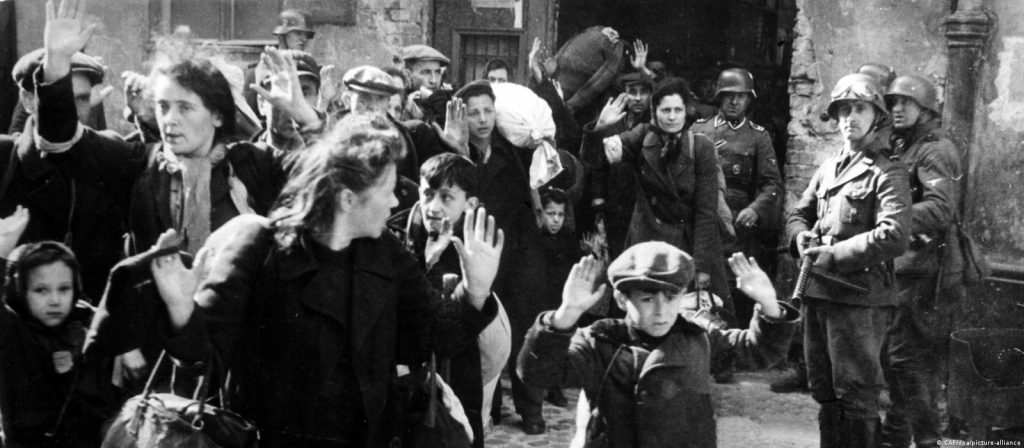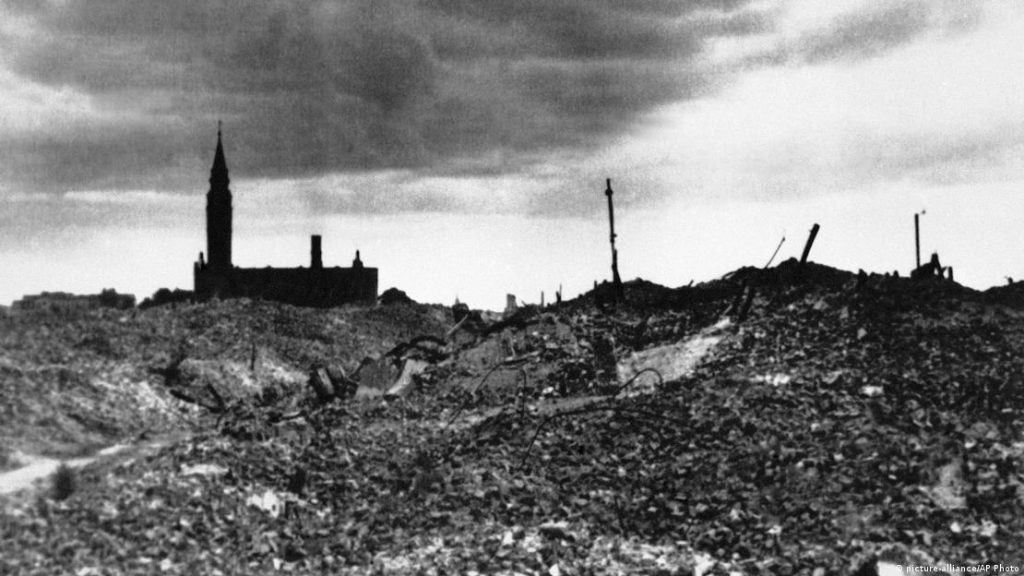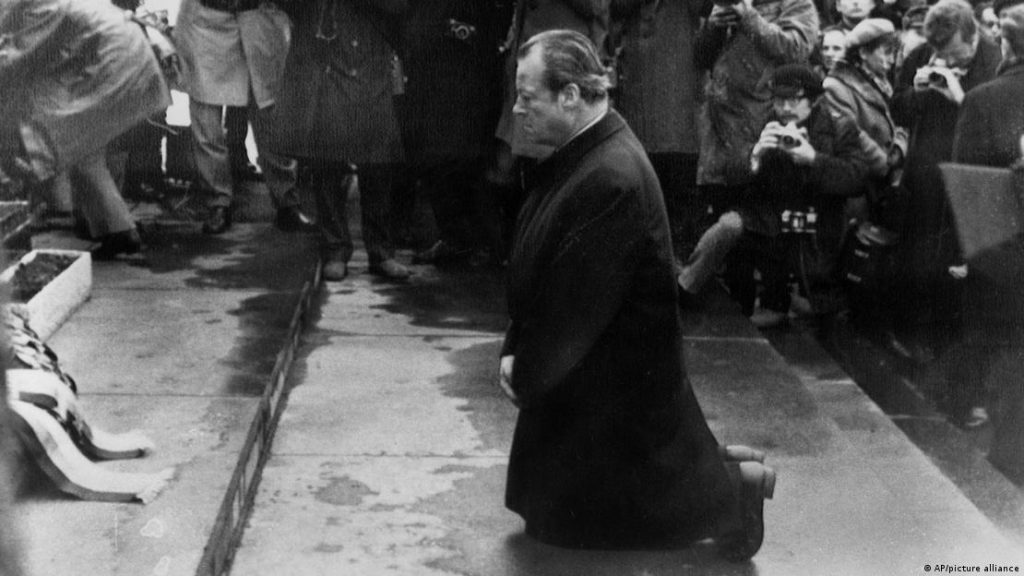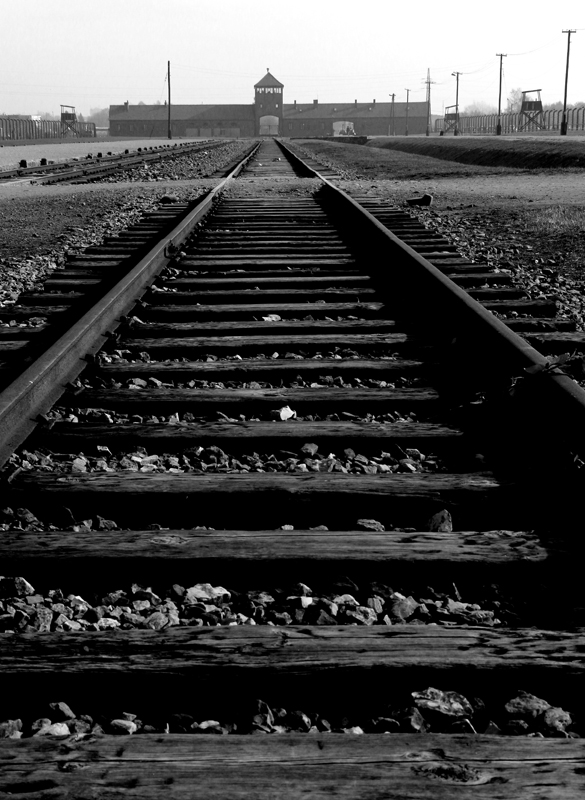Eighty years ago, Jews imprisoned in the Warsaw Ghetto rose up against the German occupiers.
It was the largest act of Jewish resistance against the Nazis.

ABOVE: one of the most iconic photographs from the Holocaust. Jewish women and children are forcibly removed from what was a hidden bunker below ground in the Warsaw Ghetto. They were deported to either the Majdanek or Treblinka extermination camps. The photo was in “The Stroop Report”, the official report prepared by General Jürgen Stroop for the SS chief Heinrich Himmler, recounting the German suppression of the Warsaw Ghetto Uprising and the liquidation of the ghetto in the spring of 1943.
In a photograph analysis after the war, some of the people were tentatively identified by surviving family members. The boy was never affirmatively identified. The photographer was Franz Konrad, an Austrian mid-level commander in the SS of Nazi Germany who was an administrative official responsible for the “Werteerfassung” or “recording of valuables” in the Warsaw Ghetto. He earned the nickname “the King of the Warsaw Ghetto”. The photo was one of 52 photos he took which were in The Stroop Report. After the war, Konrad and Stroop stood trial and were convicted of killing seven Jews and sending 1,000 others to death camps. Both were executed in March 1952.
The soldier on the far right pointing the rifle was Josef Blosche, who was picked up years after the war by the East German secret service. While being interrogated, Blosche was presented a copy of the photo, the copy found in the intact SS files on the Stropp Report that fortunately were overlooked in the the haste of Nazis to flee Berlin. (I’ll have more about the survival of Nazi records in my Holocaust series). On the back of that photo he had written “I am the SS man with a rifle in his hands in a combat position and with a helmet on his head, aiming my rifle at the little boy” and he signed it “Josef Blosche, Berlin”. Blosche was sentenced to death for war crimes and executed in 1969.
As far as the boy, this photograph very much represents his traumatic experience in the Holocaust. It’s fitting that we are not able to personalize the photo too much. This photo has become an icon – a photo that represents so many survivors whose childhood was robbed from them by the German Nazis. And this boy stands for that childhood that went missing.
22 APRIL 2023 — The date of 19 April remains a special day in Warsaw. Sirens sound at noon to commemorate the greatest act of Jewish rebellion in the Second World War. On that day, 80 years ago, several hundred fighters took up arms against the Nazi forces that had come to annihilate the Ghetto. Said Marek Edelman, one of the leaders of the uprising and one of the few survivors:
“We knew perfectly well that we didn’t have any chance of winning. We fought so that the Germans would not be allowed to decide when and where we died”.
The uprising lasted about 1 month. On 16 May 1943, the Nazi occupiers began burning down the Ghetto’s buildings one by one.
Edelman died in 2009 at the age of 90, kept alive he said “through the years by the memory of those who perished”. His story is told in “Shielding the Flame“, a book by Hannag Krall, a prominent Polish journalist, who awakened Polish consciousness of a common Polish-Jewish heritage through publication of the book – a long interview with Marek Edelman. It is a very well-written history, and my thanks to Anna Ciszek, head of my Holocaust research team in Poland, for recommending the book.
There is currently under development a Museum of the Warsaw Ghetto (due to open in 2025) which will chronicle in detail the history of the uprising. And below I have a link to quite detailed review. But the story in brief:
The Germans, who had occupied Poland since the fall of 1939, set up the Ghetto in October 1940. It was the biggest Jewish ghetto in the occupied regions of Europe. And it was from here that 300,000 people were sent to their deaths in the gas chambers of the extermination camps. After the deportation of the last of those 300,000 to the Treblinka extermination camp northeast of Warsaw in the summer of 1942, there were only an estimated 50,000 people left living in the Warsaw Ghetto in spring 1943. The only way out of this ghetto hell seemed to lead to the gas chamber. The SS began plans to dissolve the Ghetto in the course of 1943.
There had developed in the ghetto a Jewish Combat Organization (ZOB). Members of the ZOB joined with the Jewish Military Union (ZZW) and other resistance groups to rise up against the German occupiers. Weapons were being smuggled into the ghetto. Their motto was that it was better to die fighting than be burned to ashes in the crematorium of an extermination camp.
The uprising began on April 19, 1943, with a shooting attack on an SS column by Jewish resistance fighters, mostly young men and women. The Nazis had marched into the Ghetto to start with its dissolution. It was the Jewish week of Passover. The roughly 1,000 Jewish fighters, who received some support from Polish partisans, had much too little weaponry and ammunition and were absolutely no match for the German troops. Despite this, they managed to engage the German soldiers under the command of the SS-Brigadeführer Jürgen Stroop (noted above) in weeks of fierce fighting. The Germans set houses on fire with flamethrowers, and most of the Jewish resistance fighters were killed in battle or executed. The last inhabitants of the Ghetto were either murdered there or deported to the extermination camps of Treblinka and Majdanek. When the last bunker was discovered, the ZOB headquarters, the fighters who had hidden there, including the key leader of the uprising, Mordechai Anielewicz, committed suicide.
On 16 May 1943, Stroop ordered the start of the burning down of all ghetto buildings one by one, starting with the Great Synagogue in Warsaw. In writing in his final report to his superiors he noted: “The Jewish Quarter in Warsaw is no more.”

The Warsaw Ghetto was reduced to rubble by the Germans in 1943. It is reported many remained buried under the rubble.
Very few people survived the massacre. One group of insurgents, with its leader, Marek Edelman, evaded the surrounding German forces by fleeing through the sewage system and left the Ghetto in a truck. Edelman continued fighting in the underground movement.
For a very good, detailed history of the uprising, produced by the Museum of the History of Polish Jews, click here.
Marek Edelman stayed in Poland after the war. He became a doctor, a human rights activist and an active member of the anti-communist opposition. As I noted, he was one of just a few eyewitnesses who kept alive the memory of life in the Ghetto and the uprising. Edelman and his friends often had to break the law to do so, because the communists had their problems with the history of Jewish life in Poland and sometimes themselves stoked the fires of antisemitism. When German Chancellor Willy Brandt knelt down before the Monument to the Ghetto Heroes in Warsaw in 1970, the Polish communists were so flabbergasted that not one Polish newspaper reported anything on the incident:

For anniversaries of the start of the Uprising, many people in Warsaw and other Polish cities wear yellow boutonnieres that are handed out by the Museum of the History of Polish Jews. Every year, 450,000 daffodils do service in this way. That is how many people were living in the Ghetto in the spring of 1941 on 307 hectares (759 acres), about 2% of the surface area of Warsaw.
This year, unlike in earlier years, there were barely any original eyewitnesses from 1943 at the commemoration events. One participant told me “My generation still had grandparents that we could ask. My children don’t have this chance anymore”.
For this reason, it is all the more important that the message embodied by this day goes out to the entire world: There are people even today who deny the Holocaust. And there are barely any eyewitnesses who can be asked about it. That is why this moment of commemoration is partly there to show that this unimaginable crime really took place and that so many millions of people lost their lives.

Violent conflicts that tear communities apart do not cease with the end of bloodshed; in the aftermath of violence, representations of the past often become a battleground themselves. In this collision between history and memory, addressing the wounds of the past becomes integral to reconstructing communities in the present. In the words of James Young, the Distinguished University Professor of English and Judaic Studies at the University of Massachusetts Amherst:
“History is what happened. Memory is the recollection that binds what happened to ourselves in the present”.
The relationship between memory and history is all the more fraught in the case of genocide. If there is always a chasm between the events of the past and our ability to comprehend them – if the past is a foreign country, as the British novelist L.P. Hartley once wrote – then that gap is even more challenging for scholars of genocide. The problem is not only that we struggle to accept that human beings can commit such acts of mass violence. The scale of killing also means that most victims do not have time to leave behind accounts and perpetrators often do not document their crimes, so that historians are faced with the challenge of how to reconstruct this past.
Yet the study of genocide assumes that how genocide occurred is explicable, even if “why” it happened cannot be fully understood. In the case of Holocaust studies, this approach seeks to dispel the mystifications that see the Holocaust as an event somehow outside of human history; the latter approach seems to take the causes of the genocide outside of the hands of humans, which is perhaps a reaction to our hesitancy to acknowledge that human evil is present in history and therefore present in human beings.
The twentieth century left behind a painful and complicated legacy of massive trauma, monstrous crimes, radical social engineering, and collective/individual guilt syndromes that needed to be deconstructed. More often than not, the past appears as a devastated landscape full of corpses, dashed illusions, failed myths, betrayed promises, and unprocessed memories. Now over two decades into the twenty-first century, the century repeats. Not just in Ukraine but in Afghanistan, Ethiopia, Haiti, Iraq, Palestine, Somalia, Syria, Yemen – the list seems endless.
But the historical experience of the previous century still fundamentally shapes how we envisage our contemporary world at personal, local, national, continental, and global levels. So you need historians and other experts, to provide perspective, who can combine profound knowledge and understanding of the longer, deeper structural processes of history.
I am the most fortunate of writers because for my series on the Holocaust, genocide and dehumanization I have had the opportunity for lengthy conversations with many such historians and experts, the most prominent being:
– Jacques Semelin, a professor at the Institute of Political Studies of Paris at SciencesPo, a selective research university of international standing, where Jacques created a pioneering course on genocide and mass violence, as well as programs on the civil resistance processes in dictatorships, work is based on a multidisciplinary approach using history, political science, and social psychology. He was the first genocide expert to take this approach. And it is not just the study of the Holocaust. He has done a deep dive into the Rwandan genocide, the ethnic cleansing in Bosnia Herzegovina, as well as the atrocities in Syria, respecting the specificities of each of these appalling phenomena. He is the subject of my first documentary due out later this year.
– Dr. Edyta Gawron, a historian who works as a Professor in the Institute of Jewish Studies, Jagiellonian University in Krakow, Poland. As a specialist in the 20th century history of Polish Jews and Holocaust studies Dr. Gawron cooperates with various academic institutions and museums in Poland and abroad. You can watch our video interview by clicking here.
– Serge Klarsfeld who, with his wife Beate, hunted, confronted, prosecuted, and exposed Nazi war criminals all over the world, tracking down the notorious torturer Klaus Barbie in Bolivia. They have been sent to prison for their beliefs and have risked their lives protesting anti-Semitism behind the Iron Curtain in South America and in the Middle East. They have been insulted and exalted, assaulted and heralded; they’ve received honors from presidents and letter bombs from neo-Nazis. Serge taught me that while no single account can claim to provide complete knowledge of an event like the Holocaust, the Holocaust nevertheless must be approached simultaneously from epistemic, logical and ethical choices. But it requires an extraordinary amount of due diligence. You watch my video interview with Serge by clicking here.
– Pawel Sawicki, a press officer and an educator of the Auschwitz Memorial/Auschwitz Birkenau State Museum, who is responsible for the social media activity of the Memorial that is followed on different platforms by over 1,5 million people. He is the editor-in-chief of the monthly online magazine Memoria, co-author of the “On Auschwitz” podcast, and author of the album “Auschwitz-Birkenau. The place where you are standing” that compares 1944 images from Auschwitz II-Birkenau with the authentic site of the Memorial today. No one has a better understanding of the history of Auschwitz, the symbolism of the site and its significance. We’ll have some video conversations later this year.